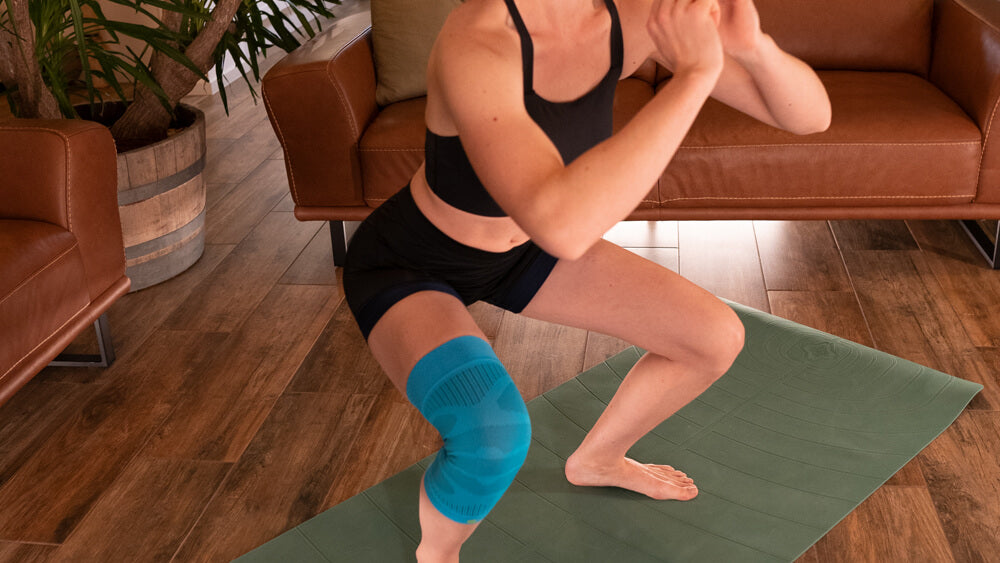Painkillers are a very common method of pain management. But while they may be prescribed for certain conditions, they’re more a way to cover up pain rather than a means of fixing the underlying cause. Experts agree that you should use them alongside non-pharmacological pain management methods. So, from exercise to bracing to mindfulness techniques, here are a few tried and true non-painkiller ways to relieve pain.
Exercise
It might seem counterintuitive to move when pain signals tell us otherwise. But exercise is crucial to our health, as well as injury recovery and overall pain relief. When less active, your muscles tend to weaken and stiffen, increasing pressure on tendons, ligaments, and spinal disks.
But when you're active, you keep the muscles strong and flexible when you are more active. Current research from the AAFP shows that exercise is beneficial for back pain, with studies finding it results in moderate improvement in pain in the short and long term and some improvement in function. The AAFP also notes that gentle exercise (like walking) relieves knee and hip osteoarthritis pain.
Consult a physiotherapist if you plan to exercise after an acute injury or with a medical condition. They’ll work with you to create a tailored exercise plan.
Exercise also increases endorphins. And endorphins are the body’s “natural painkiller,” acting similarly to morphine to relieve pain.
Bracing for non-pharmacological pain management
 GenuTrain Knee Brace
GenuTrain Knee Brace
Getting a quality brace can also help relieve pain in a few key ways:
- Compression braces like our GenuTrain Knee Brace relieve pressure by activating your muscles - your body’s natural support network. Essentially, all the little meshes in compression knit fabric put gentle pressure on your muscle fibres, helping them communicate better with your brain and assist support and movement. Splint and hinged braces like our ManuLoc and SecuTec OA provide direct external support.
- Our compression braces also often include viscoelastic pads that work with the compression knit to massage away pain as you move.
- Pain often negatively affects your proprioception - your ‘awareness’ of how you move and position your body - as pain signals interrupt other nerve signals. Reduced proprioception will affect your gait, balance, and muscle activation speed, potentially leading to damaging, painful movements. Along with minimising these pain signals through support and movement, compression knit fabric helps retrain your muscles so they can better transmit and receive messages to and from the brain.
Mind-Body
Mind-body techniques can help retrain your brain and trigger the relaxation response. For instance, Cognitive Behavioural Therapy (or CBT) teaches techniques to help you think differently about your pain, reducing your perception of it.
Other techniques like meditation and deep breathing exercises activate a physiologic relaxation response. This response is the opposite of the stress response. According to the Journal of Psychiatry, meditation (when done frequently and long-term) can change the structure of your brain, making you a little less sensitive to pain. And according to a study published in the National Library of Medicine, it can help you decrease cognitive control in the prefrontal cortex and increase sensory processing in the right posterior insula. Or, to put it more simply, you’ll be able to regulate the feeling of pain as it comes, reducing it by up to 22%.

Hot and cold
Ice packs are great for numbing painful areas and reducing swelling. Heat packs help reduce muscle spasms and relieve associated tension and pain. For the best results:
- Apply an icepack to the affected area for 15-20 minutes a few times a day.
- Apply a heat pack to the affected area for 20-30 minutes at a time.
- Always wrap an ice pack in a tea towel before applying to avoid skin damage.
- Ice packs are best for the initial stages of acute injuries. You can use them longer-term. Avoid applying them to stiff or tight muscles or joints, as they can worsen that tightness.
- Heat packs are best for later stages of injury and relieving stiffness associated with chronic conditions like arthritis. You shouldn’t use them on freshly injured joints or areas that are red or warm.
Physios and Osteos
Pain management specialists like physiotherapists and osteopaths can also help relieve pain. They can manipulate stuck joints and vertebrae, massage tense muscles, ease pinched nerves, apply hot, cold, and other therapies, and recommend tailored exercise plans.
Whether your pain results from an injury, medical condition, or an over-sensitive, panicked nerve, getting specialist advice is always a good idea.
To sum up
Pain isn't easy to live with, whether it's acute or chronic, neuropathic or musculoskeletal. But you can use some non-pharmacological pain relief methods to manage it. Meditation, hot and cold therapy, bracing and exercise, and visiting a physiotherapist on occasion will go a long way to relieving pain and helping you get back into daily activities.
Explore more braces for pain management: Originals - Medical Braces and Supports
If you require assistance selecting the right product for your needs or wearing the brace, call us on 098015660 or contact us via live chat.
Do you have private health? Most private health extras will cover Bauerfeind Products. Check to see if yours is included. Bauerfeind Private Health Insurance Inquiry.
















